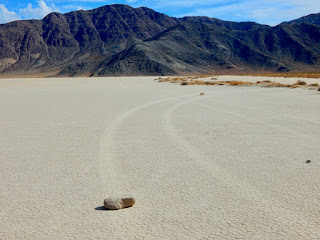I visited Death Valley National Park with a friend in the first week of November. Although the park is like a desert, it is quite diverse, featuring mountains, canyons, sand dunes, and salt flats. The park is also colorful. Death Valley is notorious for extreme heat during summer - temperatures can be 120+ degrees F. Death Valley also holds the world's hottest recorded temperature - 134 degrees F which happened in 1913.
Our trip was cooler - highs were around 90 F and lows around 60 F. And the thermometor at the Furnace Creek visitor center shows Death Valley can be cool.

Our trip was cooler - highs were around 90 F and lows around 60 F. And the thermometor at the Furnace Creek visitor center shows Death Valley can be cool.

Las Vegas McCarran airport (LAS) is the closest airport to Death Valley and is a 2 hour drive. My flight to LAS flew over the Grand Canyon. After meeting my friend in the airport we had lunch at an Italian restaurant in the Venetian hotel. This hotel is a replica of Venice, Italy and features indoor canals and a sky theme ceiling.




We stayed at The Ranch in Death Valley. This resort features a spring-fed pool which we found relaxing and refreshing after a long day of hiking. It is also close to The Inn which is an upscale lodge. We visited the Inn Dining to enjoy the evening air. The resorts have palm trees, but they were probably planted by the lodge owners.


Death Valley is mostly sunny year round and rain is rare. Lots of opportunities to enjoy spectacular sunrises and sunsets. One day, we did a horseback ride during sunset.


We visited the Mesquite Flat Dunes and hiked to the peak of the largest sand dune. The sand felt cool.


Artist Palette, where the mountains show off their colors. Oxidiation of natural elements cause the various colors. Iron elements produce red and yellow shades. Mica produces green colors. Maganese produce lavender and purple. Some mountains resemble mint chocolates.


Racetrack, a wide open dried lake bed. Rocks end up on the lake bed due erosion, and they move over time leaving trail marks. The cause of the rock movements were a mystery for decades, until researchers identified an interesting phenomenom in 2014. Warning: if you decide to visit the Racetrack, getting there involves driving 27 miles on a rough, washboard road. So you need a high clearance vehicle such as an SUV or Jeep, or you need really good off-roading skills.


Around 7 miles from Racetrack, we stopped at the Teakettle Junction. Great place for a break and we had a picnic lunch here. Someone hung a tea kettle with a message that they were engaged the day before we visited.


Ubehebe Crater, created by volcanic explostions. The crater is 600 feet deep and 1/2 mile across. It is a beautiful site with the orange colors and grooves.


Salt Creek hike. This creek is complete dry during the summer months, though water flows from November to May. Yep, water appears in Death Valley sometimes.


Zabriskie Point, filled with mountains of ripples. Lots of hiking trails here. We did the hike to the Red Rock Cathedral - this trail led to other trails to the Golden Canyon.


Dante's View, an overlook in Death Valley. At nearly one mile above sea level, this is one of the highest points in Death Valley. The most noticeable view is of the Badwater Basin which is the lowest point in North America at 282 feet below sea level.


Natural Bridge. Formed by flooding, these rocks resemble a bridge. Just beyond the bridge is a dry waterfall.


Mosaic Canyon hike. There were some narrow sections in the trail. Some of the rock resemble marble like countertops. 

Charcoal Kilns. These beehive shaped structures originially existed to provide fuel for nearby mines. We had lunch inside a kiln - cool temperatures which is a retreat from the hot sun.




















No comments:
Post a Comment